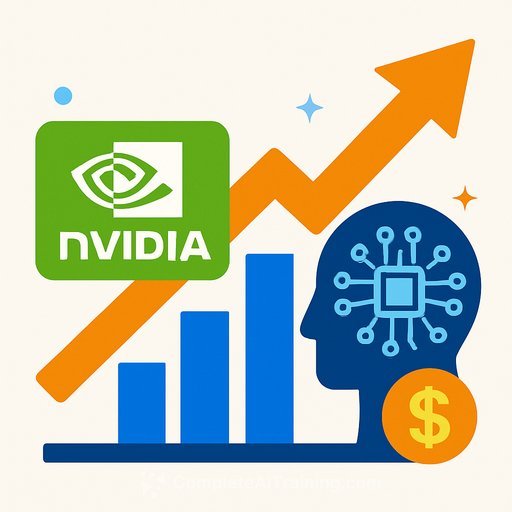Nvidia's AI surge: What sales teams should do now
Nvidia posted a quarter that cleared the bar by a mile. Revenue hit $57bn, up 62% year over year, with data center sales at $51bn (+66%). The next quarter outlook is about $65bn, pushing shares up around four percent after hours. That's a loud signal: buyers are still signing big checks for AI infrastructure.
Jensen Huang said demand for Blackwell AI systems is "off the charts" and that "cloud GPUs are sold out." That phrase matters for sellers. Scarcity drives urgency, reshapes budgets, and opens room for higher-value bundles.
Market mood: nerves in public, deals in private
Talk of an AI bubble won't die, but the numbers forced a reset. Analysts framed the quarter as a "by how much" beat, not an "if." Translation for sales: the spend is real, even if headlines wobble week to week.
Nvidia recently became the first company to reach a $5tn valuation. Meta, Alphabet, and Microsoft all said their AI budgets are swelling. Even with warnings about froth from voices like Sundar Pichai and economist Simon French, procurement keeps moving.
Where the next orders come from
Huang previously flagged $500bn in AI chip orders through 2025. CFO Colette Kress told analysts that total will "probably" grow, though US export limits to China are compressing part of demand. She also argued the US must win the support of every developer, including those in China, and said Nvidia is staying engaged with both governments.
On the same day, Huang appeared alongside Elon Musk to tout a large Saudi data center running on hundreds of thousands of Nvidia chips, with xAI as the first customer. Reports said the US Commerce Department approved sales of up to 70,000 advanced chips to state-backed firms in Saudi Arabia and the UAE, following White House talks with Crown Prince Mohammed bin Salman.
Why this matters for sellers
- Budgets are moving to compute first. Buyers anchor AI roadmaps to GPU supply, then fund workload migrations, data pipelines, and services around it.
- Scarcity rewrites your pitch. When "GPUs are sold out," customers pay for delivery, reliability, and risk reduction-not just specs.
- Decision makers are stacking up. CIO/CTO initiate, CFO signs, product leads and data leaders validate. Build a multi-threaded deal from day one.
- Geography is a factor. Middle East, US hyperscalers, and well-capitalized enterprises will move fastest. China-facing deals carry policy risk-plan contingencies.
Sales plays that land right now
- Capacity-first bundling: Pair reserved compute with integration, MLOps setup, data readiness, and support SLAs. Sell certainty and time saved.
- Bridge the gap: Offer interim capacity plans (hybrid, multi-cloud, inference offload) while customers wait for next-gen racks.
- Outcome metrics: Lead with time-to-train, tokens per dollar, throughput per rack, and uptime. Make cost per unit of insight the headline.
- Executive math: Map GPU allocations to product launches, ARR impact, or cost takeout. Hand finance a clean ROI sheet with realistic milestones.
- Compliance cover: For cross-border buyers, include export checks, data residency options, and auditable controls in the proposal.
Deal questions to qualify hard and fast
- Which workloads are blocked by compute limits today, and what's the dollar cost of delay?
- What's the minimum viable capacity that unlocks a launch in the next two quarters?
- Who owns the budget and what event forces a decision (renewal, product deadline, board target)?
- What risks would stop this project-supply, policy, integration-and how do we neutralize each?
Objections you'll hear-and how to handle them
- "Isn't this a bubble?" The spend is tied to live deployments, not theory. Guide to a phased plan with measurable checkpoints and stop/go gates.
- "We can't get capacity." Offer reservations, interim workload placement, and a schedule with penalties/credits for slips.
- "Costs are unclear." Provide a unit-economics view: cost per training run, cost per million tokens, and utilization plans that cap waste.
30/60/90-day action plan
- Next 30 days: Rebuild ICP around buyers with near-term capacity needs (hyperscalers, AI-native SaaS, sovereign compute projects). Refresh talk tracks for scarcity and ROI.
- Next 60 days: Stand up a "capacity desk" with standard offers: reservations, bridging, and managed MLOps. Publish reference architectures by workload.
- Next 90 days: Lock two lighthouse deals with clear outcome metrics and customer quotes. Turn them into repeatable playbooks for field and partners.
Strategic context
Nvidia sits at the center of AI infrastructure, with deep ties to OpenAI, Anthropic, and xAI. The structure of some deals has raised eyebrows-especially the reported $100bn investment in OpenAI-but the takeaway for sellers is simple: capacity is the scarce resource, and everyone is optimizing around it.
For official updates and numbers, check Nvidia Investor Relations. If you want to skill up your team on practical AI tools and workflows by job role, see AI courses by job.
Your membership also unlocks:






